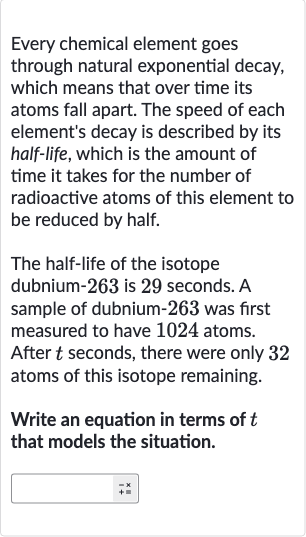AI tutor
Welcome to Bytelearn!
Let’s check out your problem:

Every chemical element goes through natural exponential decay, which means that over time its atoms fall apart. The speed of each element's decay is described by its half-life, which is the amount of time it takes for the number of radioactive atoms of this element to be reduced by half.The half-life of the isotope dubnium is seconds. A sample of dubnium- was first measured to have atoms. After seconds, there were only atoms of this isotope remaining.Write an equation in terms of that models the situation.
Full solution
Q. Every chemical element goes through natural exponential decay, which means that over time its atoms fall apart. The speed of each element's decay is described by its half-life, which is the amount of time it takes for the number of radioactive atoms of this element to be reduced by half.The half-life of the isotope dubnium is seconds. A sample of dubnium- was first measured to have atoms. After seconds, there were only atoms of this isotope remaining.Write an equation in terms of that models the situation.
- Question Prompt: Question prompt: Write an equation in terms of that models the decay of dubnium- atoms over time.
- Identify Initial Quantity and Half-life: Identify the initial quantity and the half-life . The initial quantity of dubnium atoms is given as . The half-life of dubnium is seconds. seconds
- Determine Decay Factor: Determine the decay factor per half-life. Since the quantity of atoms is halved every half-life, the decay factor is .
- Write Exponential Decay Formula: Write the exponential decay formula.The general formula for exponential decay is , where is the remaining quantity after time , is the initial quantity, and is the half-life.
- Substitute Known Values: Substitute the known values into the formula.We know that and . We want to find the equation that models the situation after seconds when the remaining quantity is .
- Verify Equation: Verify the equation with the given condition.We are given that after seconds, there are only atoms remaining. Let's check if the equation works for this condition.Since is and is , we can rewrite the equation as:The equation holds true for the given condition, so there is no math error.
More problems from Write exponential functions: word problems
QuestionGet tutor help
QuestionGet tutor help
QuestionGet tutor help
QuestionGet tutor help
QuestionGet tutor help
QuestionGet tutor help
QuestionGet tutor help
QuestionGet tutor help
QuestionGet tutor help
